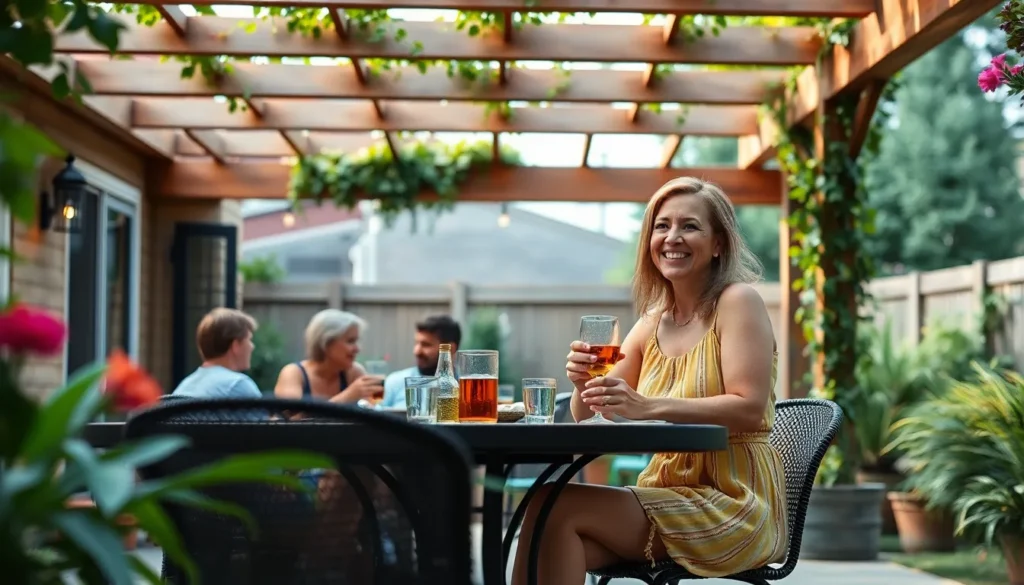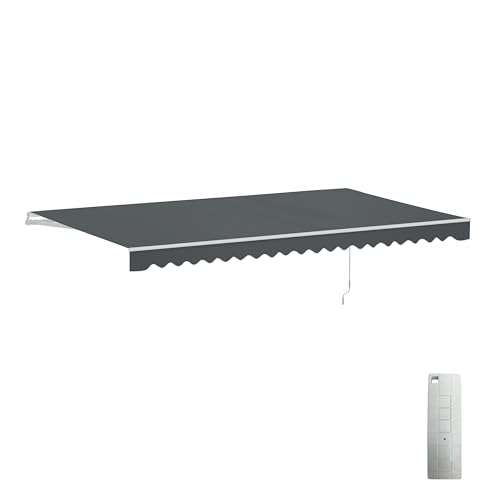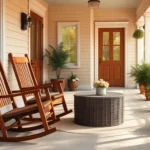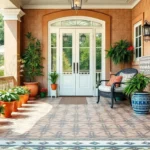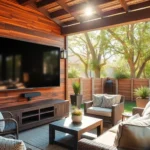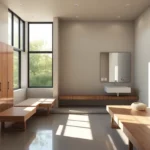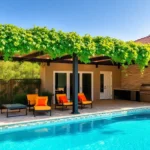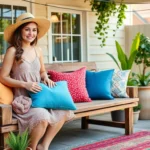Transform your outdoor space into a year-round retreat with the perfect patio roof that combines style and functionality. We’ve all experienced the frustration of canceling outdoor gatherings due to unexpected weather or the discomfort of harsh afternoon sun beating down on our favorite patio furniture.
The right patio roof solution doesn’t just protect you from the elements – it creates an inviting outdoor room that extends your living space and adds important value to your home. Whether you’re dreaming of intimate dinner parties under the stars or peaceful morning coffee sessions regardless of weather we’ll help you discover the ideal roofing option for your unique space.
From budget-friendly DIY answers to luxurious architectural statements we’re about to explore innovative patio roof ideas that’ll make your neighbors wonder why they didn’t think of it first. Let’s jump into the possibilities that’ll transform your patio from a weather-dependent space into your favorite room of the house.
Pergola Designs for Classic Outdoor Elegance
Pergolas stand as timeless architectural features that add sophisticated charm to any outdoor patio space. We’ll explore three popular material options that offer distinct aesthetic appeals and practical benefits for your outdoor roof solution.
Traditional Wooden Pergolas
Wooden pergolas create warmth and natural beauty that complements most outdoor settings. Cedar and redwood remain our top choices for their natural resistance to insects and weather damage. Pressure-treated pine offers a budget-friendly alternative that can last 15-20 years with proper maintenance.
Construction costs for wooden pergolas typically range from $2,500 to $6,000 for a standard 12×12 foot structure. Installation requires basic carpentry skills and standard tools like circular saws and drill drivers. We recommend spacing rafters 16-24 inches apart for optimal shade coverage while maintaining structural integrity.
Maintenance involves annual staining or sealing to protect against moisture and UV damage. Popular wood stain colors include natural cedar tones, rich mahogany, and weathered gray finishes. Regular inspection of joints and hardware prevents costly repairs down the road.
Modern Metal Frame Pergolas
Aluminum pergolas deliver sleek contemporary lines with minimal upkeep requirements. Powder-coated finishes resist rust and fading for 25-30 years without refinishing. Steel options provide superior strength for larger spans but require rust-prevention treatments every 3-5 years.
Installation typically costs 20-30% more than wooden alternatives but saves money through reduced maintenance. Pre-engineered kits simplify assembly with precision-cut components and detailed instructions. Professional installation ensures proper anchoring to concrete pads or existing deck structures.
Design flexibility includes adjustable louvers, integrated lighting systems, and retractable canopy options. Colors range from classic black and white to bronze and champagne finishes that coordinate with modern home exteriors. Wind resistance ratings often exceed those of wooden structures.
Vinyl and Composite Material Options
Vinyl pergolas eliminate painting and staining while maintaining classic appearance. High-quality vinyl withstands temperature extremes from -40°F to 140°F without cracking or warping. UV inhibitors prevent yellowing and brittleness that plagued early vinyl products.
Composite materials blend recycled wood fibers with polymer resins for authentic wood grain textures. Installation costs fall between wooden and metal options at approximately $3,500 to $7,500 for standard sizes. Manufacturers typically offer 20-25 year warranties against defects and color fading.
Cleaning requires only soap and water, making vinyl pergolas ideal for busy homeowners. Color options include white, tan, gray, and wood-tone finishes that won’t fade or require touch-ups. Structural components connect with hidden fasteners for clean, professional appearances.
Retractable Awning Systems for Flexible Coverage
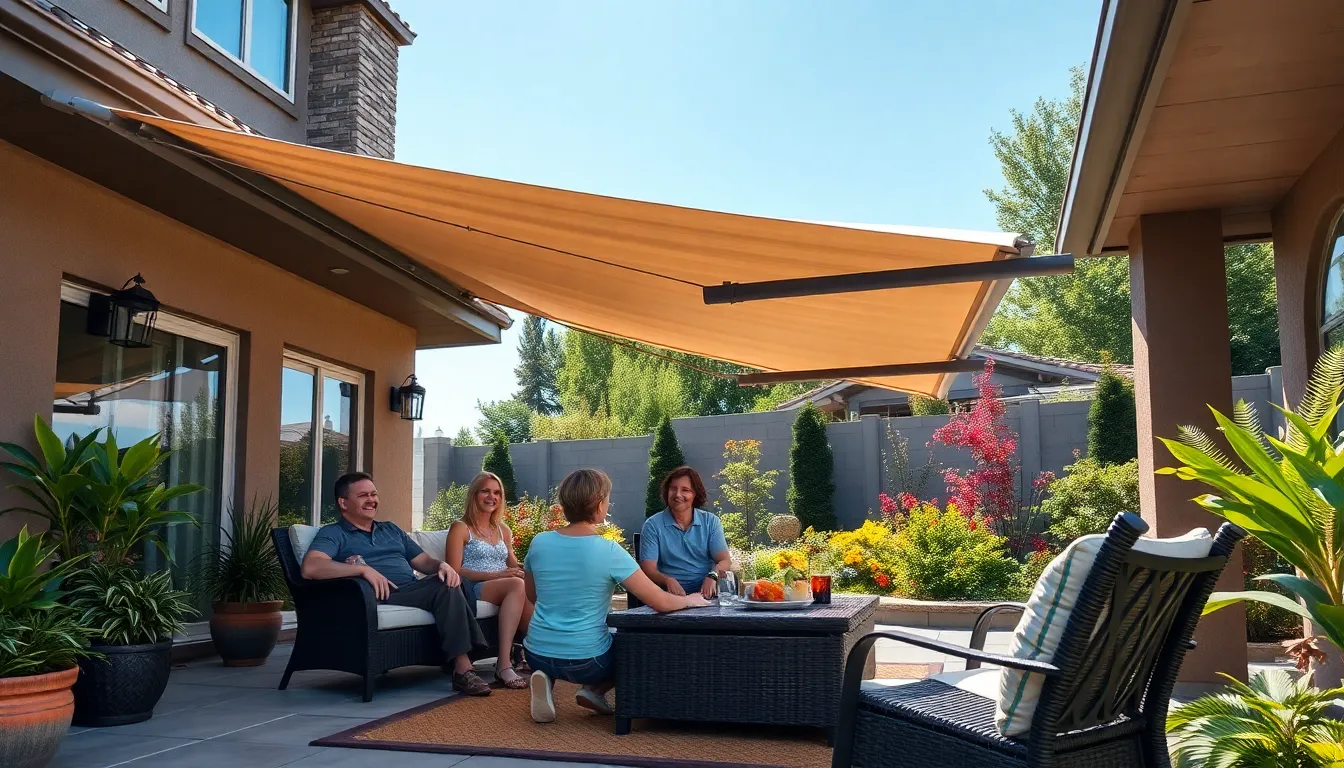
Moving beyond static pergola designs, we’ll explore ever-changing roofing answers that adapt to changing weather conditions and personal preferences.
Manual Crank Awnings
Manual crank awnings operate through a simple hand crank mechanism that allows you to extend or retract the fabric cover as needed. We find these systems particularly appealing for budget-conscious homeowners, as they typically cost significantly less than motorized alternatives while requiring no electrical connections or ongoing power consumption.
Installation proves straightforward since these awnings don’t need complex wiring or electrical components. Maintenance remains minimal with occasional lubrication of the crank mechanism and regular fabric cleaning being the primary requirements.
Durability stands out as a key advantage, with fewer mechanical parts meaning fewer potential failure points. We recommend manual crank awnings for patios where occasional adjustment suits your lifestyle and where you prefer hands-on control over automated convenience.
Motorized Remote-Controlled Awnings
Motorized awnings elevate patio convenience through electric motors controlled via wireless remotes or wall-mounted switches. These systems respond instantly to button commands, extending or retracting your patio cover without physical effort.
Advanced models feature weather sensors that automatically adjust the awning based on wind speed, rain detection, or sun intensity. We’ve observed that these smart systems can extend coverage when temperatures rise above preset levels or retract during high winds to prevent damage.
Remote control capabilities often include programmable settings, allowing you to create custom schedules for different times of day or weather conditions. Integration with home automation systems enables voice control through smart speakers or smartphone apps.
Investment costs range higher than manual systems, typically starting around $1,500 for basic motorized units and reaching $4,000 or more for premium models with advanced sensors and controls.
Weather-Resistant Fabric Choices
Fabric selection directly impacts your awning’s longevity and performance in outdoor conditions. We recommend focusing on three primary material categories that offer superior weather resistance.
| Fabric Type | Key Benefits | Typical Lifespan |
|---|---|---|
| Acrylic fabrics | UV resistance, color retention, breathability | 8-10 years |
| Polyester with PVC coating | Waterproofing, mildew resistance | 5-7 years |
| Solution-dyed fabrics | Superior fade resistance, consistent coloring | 10-12 years |
Acrylic fabrics excel in sun protection while maintaining breathability that prevents heat buildup underneath the awning. These materials resist fading and retain their original colors even after years of UV exposure.
Polyester fabrics with PVC coating provide complete waterproofing for areas that need protection from rain as well as sun. The coating creates a barrier that prevents water penetration while resisting mildew growth in humid conditions.
Solution-dyed fabrics represent the premium option where pigments are embedded during the fiber manufacturing process rather than applied afterward. This technique creates colors that won’t fade, streak, or wash out over time, making them ideal for areas with intense sunlight exposure.
Solid Roof Structures for Year-Round Protection
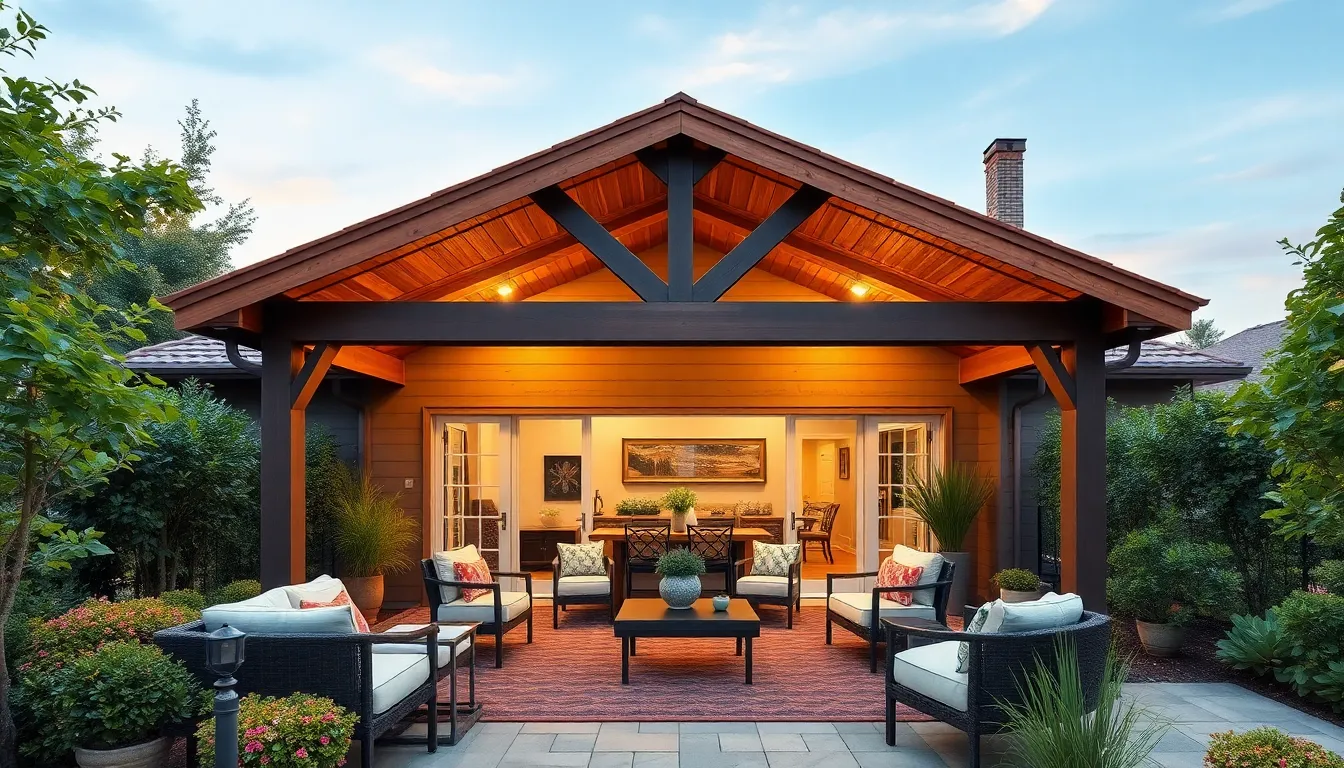
Moving beyond flexible coverage options, solid roof structures deliver complete weather protection that transforms your patio into a true outdoor room. These permanent installations shield against rain, snow, and intense sun while creating comfortable spaces you can enjoy throughout all seasons.
Gabled Roof Patios
Gabled roofs feature the classic triangular design that’s become one of the most popular choices for patio coverage. Two sloping sides meet at a central ridge, creating an attractive peaked profile that complements various home architectural styles. This configuration allows excellent water drainage while providing an open, airy atmosphere underneath.
Benefits of gabled patio roofs include:
- Vaulted ceilings that increase natural light penetration
- Enhanced architectural interest and curb appeal
- Compatibility with ceiling fans and lighting fixtures
- Superior headroom compared to single slope designs
- Effective water runoff that prevents pooling
The triangular shape addresses common light loss issues found in other enclosed patio types, making your outdoor space feel bright and welcoming even with full coverage.
Shed-Style Roof Designs
Shed roofs offer a streamlined single slope design that attaches directly to your home’s exterior wall. This clean, modern aesthetic slopes gently away from the house, creating practical water runoff while maintaining cost effectiveness. Construction simplicity makes shed roofs particularly attractive for homeowners seeking contemporary outdoor answers.
Key advantages of shed style roofs:
- Lower construction costs compared to complex designs
- Modern appearance that suits contemporary homes
- Easier installation and maintenance requirements
- Effective water drainage with single slope design
- Space efficient for smaller patio areas
The straightforward design may provide less headroom than gabled alternatives, but it delivers reliable protection with minimal architectural complexity.
Hip Roof Configurations
Hip roofs create sophisticated pyramid shapes by sloping downward from a central point on three or more sides. This balanced design offers exceptional stability and elegant aesthetics that enhance both traditional and modern home styles. Construction complexity typically increases costs, but the results provide distinctive architectural appeal.
Hip roof benefits include:
- Superior wind resistance due to aerodynamic shape
- Balanced, symmetrical appearance from all angles
- Excellent airflow and light diffusion properties
- Unique architectural element that adds property value
- Complete patio coverage with premium aesthetics
Interior views showcase pleasing geometric lines while the multi directional slopes ensure effective weather protection from any angle.
Shade Sail Installation for Contemporary Style
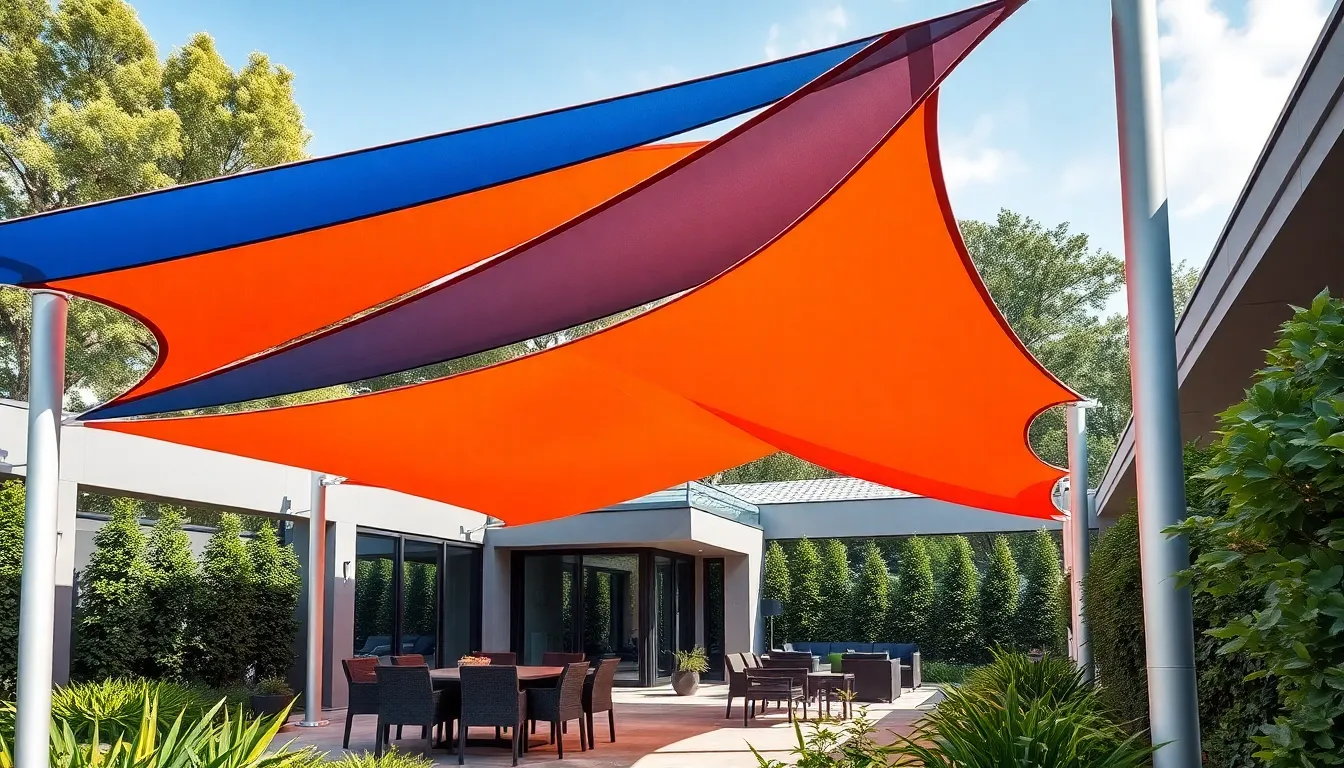
Shade sails bring a fresh, nautical inspired aesthetic to outdoor patio spaces while delivering exceptional sun protection. These sleek fabric installations create contemporary focal points that transform patios into stylish retreat areas.
Triangle Sail Arrangements
Triangular shade sails excel at creating ever-changing visual interest through their three corner tension system. We recommend utilizing the “Hypar” design technique, which alternates high and low fixing points to create a natural twist in the fabric. This twisting action keeps the sail taut, reduces wind flapping, and significantly extends the fabric’s lifespan.
Installing triangle sails individually works well for smaller patio areas, while clustering multiple triangular units creates comprehensive coverage zones. Each corner point requires secure anchoring to maintain proper tension and prevent sagging over time. The geometric shape naturally draws the eye upward, adding architectural dimension to flat outdoor spaces.
Square and Rectangle Sail Layouts
Square and rectangular shade sails provide maximum coverage efficiency for larger patio areas and deck spaces. These shapes offer straightforward installation processes since their four corner design distributes tension evenly across the fabric surface. Rectangular configurations work particularly well for covering dining areas and outdoor furniture groupings.
We’ve found that these geometric sail layouts create clean, minimalist aesthetics that complement contemporary home designs. The straight edges and right angles harmonize with modern architectural elements while providing substantial shade coverage. Quality UV resistant materials ensure these installations maintain their appearance and structural integrity throughout multiple seasons.
Overlapping Multi-Sail Designs
Combining multiple shade sails in overlapping configurations maximizes both coverage area and visual impact. We can mix triangular, square, and rectangular sails at varying heights and angles to create layered canopy effects. This approach mimics sophisticated fabric installations while providing customizable sun protection throughout different times of day.
Strategic positioning becomes crucial when designing multi-sail systems, as we must consider sun paths and seasonal changes. Expanding coverage on east and northeast sides often provides optimal morning and afternoon protection. Shadow studies help determine ideal sail placement to ensure maximum shade benefits while maintaining the contemporary aesthetic appeal these installations are known for.
Gazebo Construction for Complete Enclosure
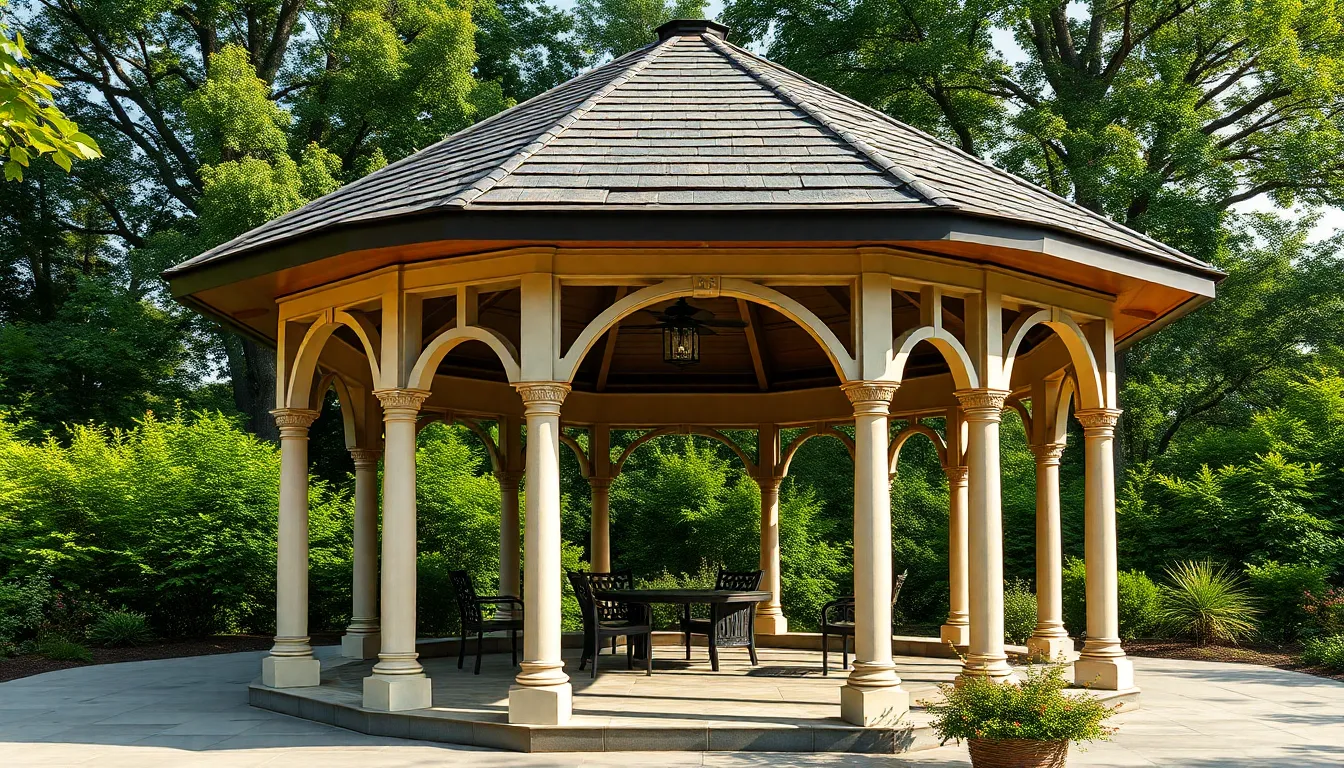
Building a gazebo offers the ultimate solution for creating a fully protected outdoor living space. These structures transform your patio into a weatherproof retreat that functions year-round.
Octagonal Gazebo Styles
Octagonal gazebos bring classic architectural beauty to outdoor spaces with their distinctive eight-sided design. The symmetrical shape maximizes interior space while creating balanced roof lines that enhance visual appeal across any industry.
Traditional shingled roofs provide the most popular option for octagonal gazebos, offering timeless elegance and excellent weather protection. These peaked roof designs create cathedral-like interiors that feel spacious and airy.
Modern metal roofing delivers contemporary style with aluminum or steel panels that require minimal maintenance. Polycarbonate variants allow natural light to filter through while maintaining structural integrity.
Airflow optimization becomes a key advantage with octagonal designs, as the eight-sided structure promotes natural ventilation from multiple directions. This design element keeps the interior comfortable even during warm summer months.
Rectangular Pavilion Designs
Rectangular pavilions excel at accommodating larger gatherings and entertainment needs with their elongated footprint. These structures fit seamlessly alongside pools, patios, or garden areas while maximizing usable space.
Gable roof systems offer the most efficient water drainage for rectangular pavilions, featuring sloped surfaces that direct rainfall away from the structure. This roof style creates impressive interior volume with peaked ceilings.
Sloped roof designs provide modern aesthetic appeal while maintaining practical functionality for weather protection. These streamlined profiles complement contemporary home architecture and outdoor design themes.
Flexible enclosure options allow pavilions to adapt to different weather conditions and privacy needs. Lattice panels, screens, or glass walls can be integrated to create partial or complete enclosure.
Open-Air vs Screened Options
Open-air gazebos maximize the outdoor experience by maintaining full connection to natural elements like sunlight and fresh breezes. But, these designs expose occupants to insects, weather changes, and outdoor debris.
Screened enclosures extend outdoor usability by incorporating mesh panels that block insects while allowing airflow. These systems prove especially valuable in regions with high mosquito populations or frequent weather variations.
Retractable screen systems offer the best of both worlds with motorized panels that can be adjusted based on conditions. Modern designs include weather sensors that automatically respond to wind, rain, or temperature changes.
Glass panel installations create four-season outdoor rooms that provide complete weather protection while maintaining visibility. These premium options often include insulated panels for thermal efficiency and year-round comfort.
Living Roof Systems for Eco-Friendly Solutions
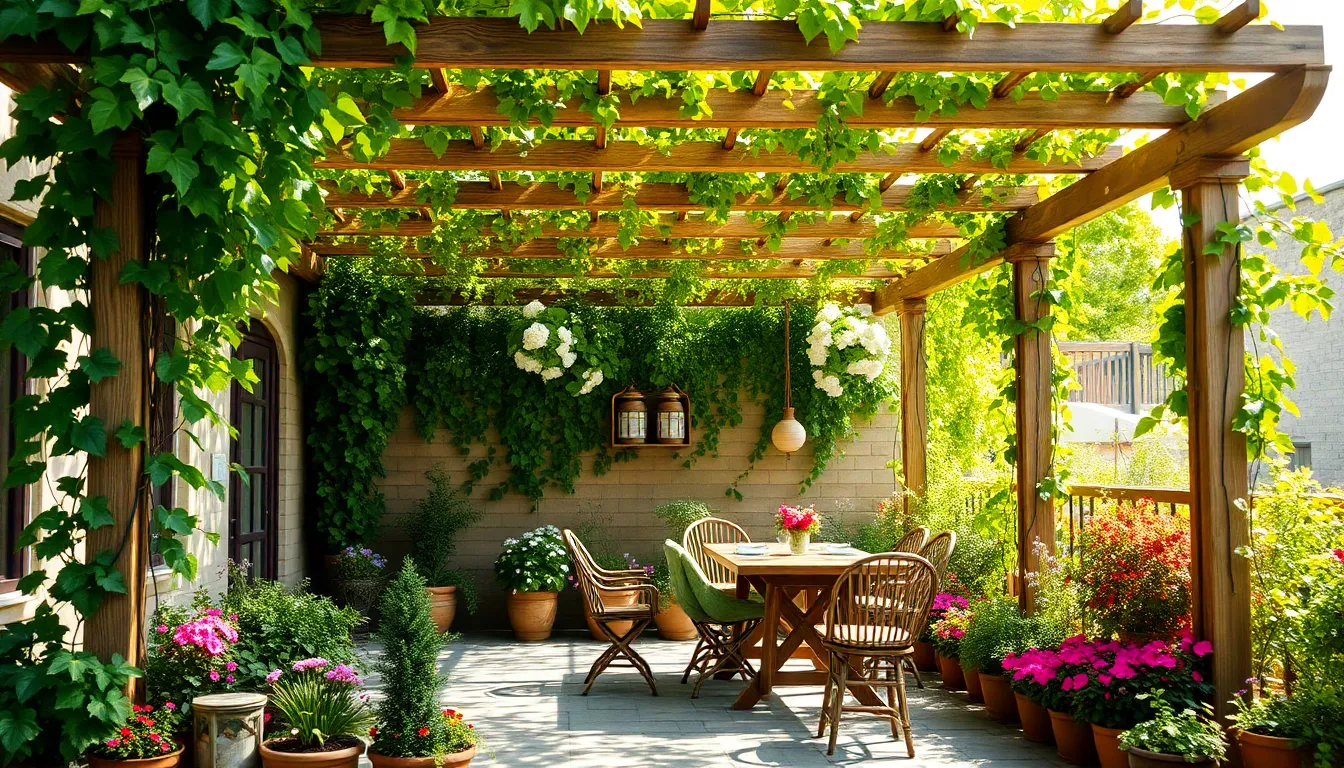
Living roof systems represent the cutting edge of sustainable patio design, combining environmental benefits with stunning visual appeal. These innovative answers reduce energy consumption while creating wildlife habitats directly above your outdoor living space.
Vine-Covered Arbor Structures
Wooden frame arbors provide the perfect foundation for climbing plants, creating natural shade through living canopies that grow more beautiful each season. Cedar and redwood frames resist decay naturally, supporting vigorous vine growth while maintaining structural integrity for decades. We recommend spacing vertical supports every 6-8 feet to accommodate mature vine weight and wind loads.
Metal arbor systems offer sleek, modern frameworks that complement contemporary patio designs while supporting extensive vegetation. Aluminum and steel structures require minimal maintenance compared to wood, with powder-coated finishes lasting 15-20 years in outdoor conditions. Galvanized steel provides the strongest support for heavy vines like mature grape or wisteria installations.
Living shade coverage develops gradually as vines establish root systems and climb upward, typically reaching full coverage within 2-3 growing seasons. Established arbor vines can reduce underneath temperatures by 10-15 degrees Fahrenheit during peak summer months. Dense foliage also improves air quality by filtering dust and producing oxygen throughout the growing season.
Green Roof Installation
Waterproof membrane systems form the critical foundation layer, preventing water damage to underlying structures while supporting plant growth above. Professional installation typically costs $15-25 per square foot, including specialized membranes designed for root penetration resistance. We advise using EPDM or modified bitumen membranes with warranties of 20+ years for residential applications.
Drainage layer components include gravel, expanded clay, or specialized plastic modules that prevent waterlogging while retaining adequate moisture for plant health. Tile Tech’s Plant-Tray™ systems simplify installation by incorporating drainage directly into modular units that sit level over existing flat roofs. Proper drainage prevents root rot and structural damage from excess water accumulation.
Growing medium selection requires lightweight soil alternatives that support plant growth without exceeding roof load limits, typically 15-25 pounds per square foot when saturated. Engineered growing media combines compost, expanded shale, and sand to create optimal drainage and nutrient content. Depth requirements vary from 3-4 inches for sedums to 8-12 inches for grasses and small shrubs.
Climbing Plant Selection Guide
Low maintenance varieties thrive with minimal care once established, making them ideal for busy homeowners seeking beautiful coverage without extensive upkeep requirements. Ivy provides evergreen coverage year-round, tolerating various light conditions and requiring only annual pruning to control growth. Boston ivy offers spectacular fall color displays while maintaining dense summer shade coverage.
Flowering climbers add seasonal color and fragrance to arbor structures, creating stunning focal points throughout the growing season. Clematis produces abundant blooms in purple, white, pink, or yellow, requiring well-drained soil and partial shade for optimal flowering. Honeysuckle delivers sweet fragrance and attracts beneficial pollinators, though some varieties spread aggressively and need regular pruning.
Edible climbing options combine beauty with functionality, providing fresh produce while creating attractive overhead coverage for outdoor dining areas. Grape vines produce fruit within 3-4 years while offering dense foliage and attractive fall colors before leaf drop. Hardy kiwi vines require both male and female plants for fruit production but provide unique, smooth-skinned fruits rich in vitamin C.
Combination Roof Ideas for Maximum Versatility
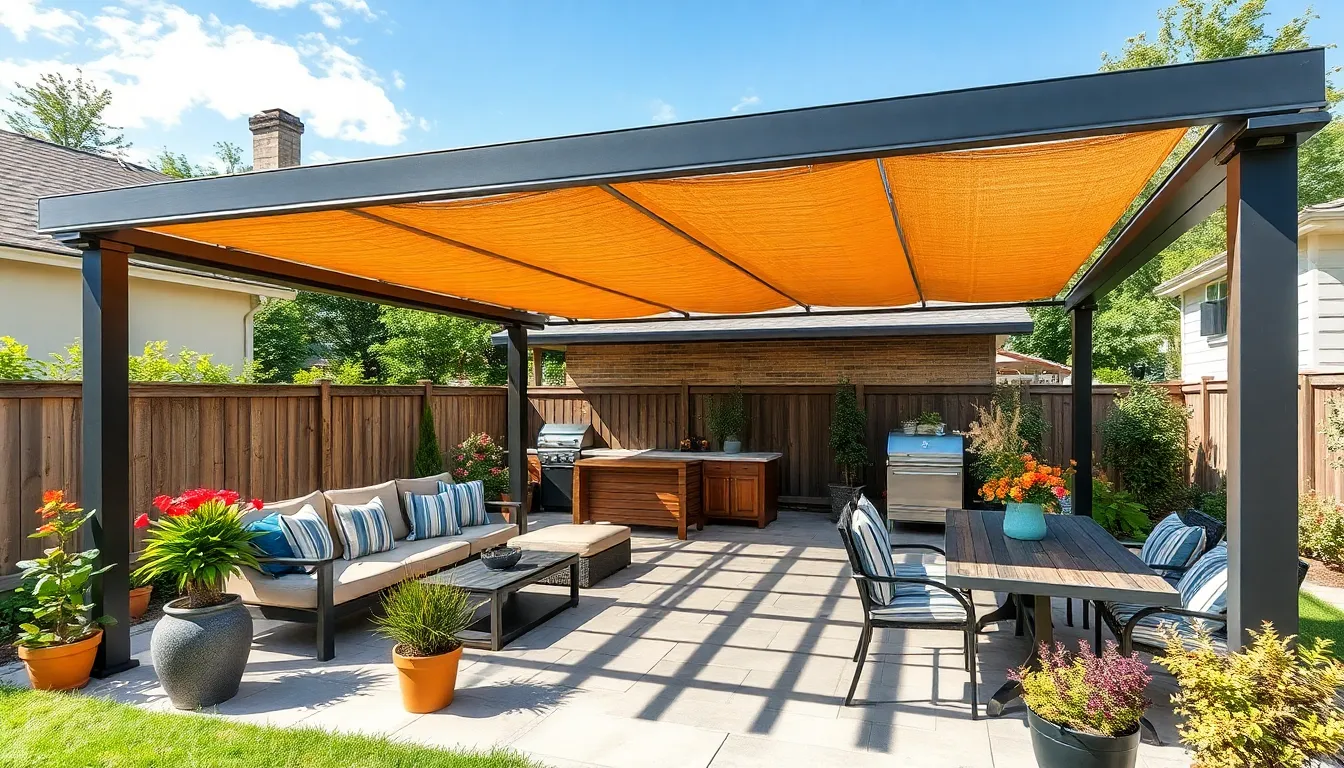
We’ve explored single-style roof answers, but combining different roofing elements offers the ultimate flexibility for your outdoor space. These hybrid approaches maximize your patio’s functionality while creating visually stunning designs.
Pergola with Retractable Canopy
Pergola with retractable canopy systems deliver the perfect balance of open-air ambiance and weather protection. We love this combination because it provides a sturdy frame with an airy aesthetic while allowing complete control over sunlight and shade. The pergola structure offers year-round architectural interest, while the retractable element adapts to changing weather conditions instantly.
This setup excels in climates with variable weather patterns, letting you enjoy open skies during pleasant days or deploy protection when rain threatens. Manual crank systems typically cost $500-$1,500, while motorized versions range from $2,000-$5,000 depending on size. Weather-resistant fabrics like solution-dyed acrylic or vinyl-coated polyester ensure your canopy withstands seasonal challenges without sacrificing style.
Partial Solid Roof with Open Sections
Partial solid roofing with strategic open sections creates distinct zones within your outdoor living area. We recommend this approach for homeowners who want guaranteed shelter over dining areas while maintaining natural light in lounging spaces. The covered portions provide complete protection from rain and intense sun, while open sections preserve airflow and connection to the sky.
Polycarbonate panels offer excellent durability and light transmission, typically lasting 15-20 years with proper installation. Wood slat configurations provide natural beauty while filtering sunlight, creating ever-changing shadow patterns throughout the day. This design works exceptionally well for patios hosting multiple activities, allowing different comfort levels within the same space.
Mixed Material Approaches
Mixed material roofing combines the best properties of different materials for enhanced function and visual appeal. We’ve seen stunning results from pairing metal roofing panels with wooden pergola structures, creating durability where needed while maintaining natural warmth. Polycarbonate sheets integrated with cedar beams offer weather protection plus organic beauty, typically reducing installation costs by 20-30% compared to single-material answers.
These hybrid designs cater to exact performance requirements like superior water resistance, enhanced insulation, or unique aesthetic preferences. Metal and wood combinations provide excellent longevity, with properly treated materials lasting 25+ years. The approach allows you to allocate your budget strategically, using premium materials in high-impact areas while choosing cost-effective options for accent elements.
Budget-Friendly DIY Patio Roof Options
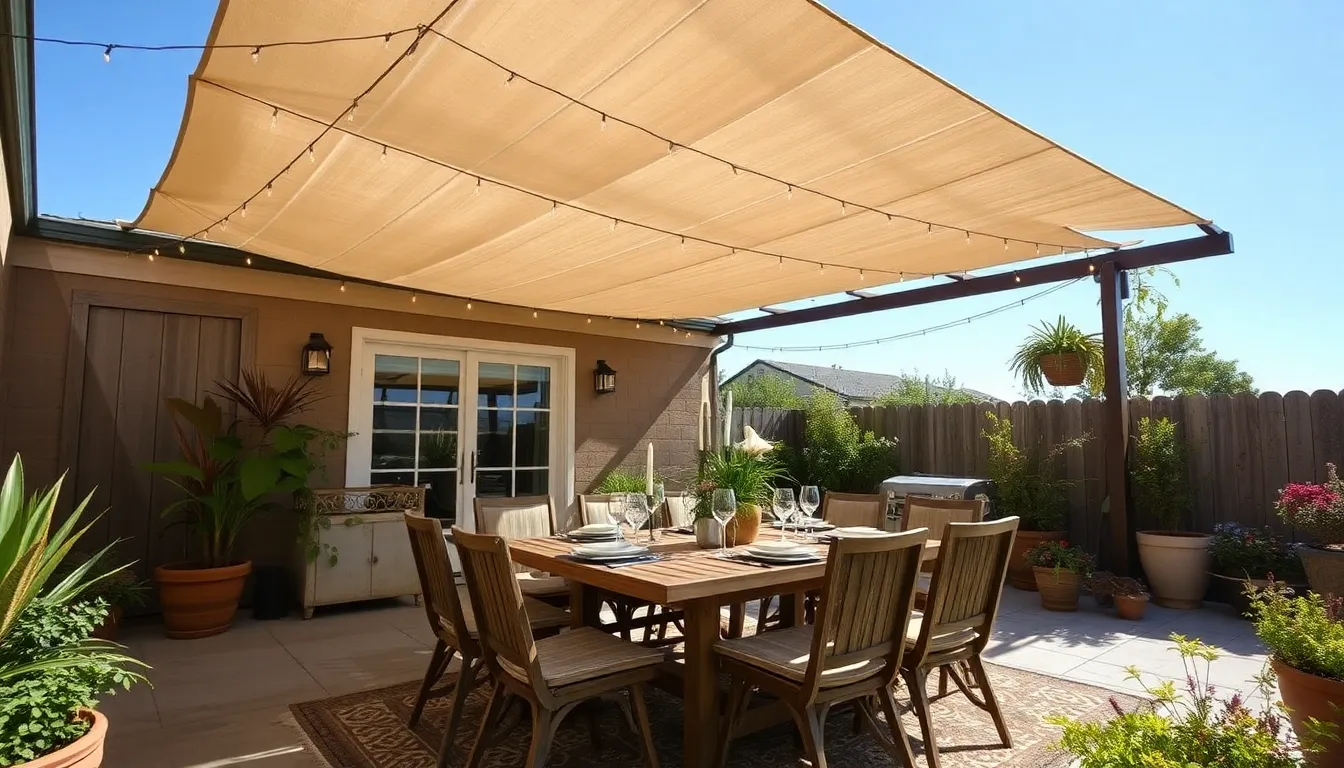
Creating an affordable patio roof doesn’t require sacrificing style or functionality. Smart material choices and creative design approaches can deliver impressive results while keeping costs under control.
Canvas Drop Cloth Coverings
Canvas drop cloths transform into effective patio coverings with minimal investment and maximum impact. These weather-resistant fabrics provide excellent UV protection while adding texture and visual interest to your outdoor space. Installing them as shade canopies takes just hours and offers the flexibility to adjust coverage based on weather conditions.
Pairing canvas coverings with string lights creates an enchanting ambiance for evening gatherings. String lights weave through the fabric edges to cast warm, diffused lighting across your patio. Adding outdoor curtains to the perimeter enhances privacy while maintaining the breezy, relaxed atmosphere that makes outdoor spaces so appealing.
Weather-resistant canvas materials withstand seasonal changes without requiring frequent replacement. Treating the fabric with waterproofing spray extends its lifespan and maintains appearance throughout various weather conditions. Removing and storing the covering during harsh winter months preserves the material for multiple seasons of use.
Repurposed Material Projects
Corrugated plastic panels offer an affordable solution for complete patio coverage under $200. These lightweight panels install quickly over basic framing and provide excellent weather protection. Sourcing recycled panels from construction sites or home improvement store clearance sections reduces costs even further.
Carport covers repurpose into unexpected patio answers with impressive durability. These pre-fabricated structures adapt easily to patio spaces and offer substantial weather protection. Modifying carport dimensions to fit your exact patio layout creates a custom look without custom pricing.
Incorporating natural elements like potted plants and DIY wall art personalizes repurposed roof projects. Hanging planters from the roof structure adds vertical gardening space while softening industrial materials. Creating custom wall art from reclaimed wood or metal accents transforms utilitarian coverings into stylish outdoor features.
Simple Lean-To Structures
Lean-to patio roofs attach directly to existing walls, making them the most straightforward DIY roof option. These sloped structures efficiently shed water while providing excellent coverage for outdoor dining and entertaining areas. Basic framing requirements keep material costs low while ensuring structural integrity.
Polycarbonate panels combined with simple lumber framing create durable lean-to roofs quickly. These lightweight panels allow natural light to filter through while blocking harmful UV rays. Installing them with basic carpentry skills takes just a weekend and provides years of reliable protection.
Vinyl sheets offer another excellent material choice for lean-to construction with minimal maintenance requirements. These weather-resistant materials resist fading, cracking, and warping over time. Securing vinyl sheets to basic wooden or metal framing creates an attractive, functional roof that complements various architectural styles.
Conclusion
We’ve explored an impressive range of patio roof answers that can transform any outdoor space into a functional and beautiful retreat. From classic pergolas and modern retractable awnings to innovative living roofs and budget-friendly DIY options there’s truly something for every home and budget.
The key is matching your roof choice to your exact needs lifestyle and aesthetic preferences. Whether you’re seeking complete weather protection with solid structures or prefer the flexibility of combination designs the right patio roof will extend your outdoor living season significantly.
Remember that investing in quality materials and proper installation pays dividends in durability and long-term satisfaction. Your patio roof isn’t just about shelter—it’s about creating an outdoor sanctuary that enhances your home’s value and your family’s quality of life for years to come.
Frequently Asked Questions
What are the main benefits of installing a patio roof?
Patio roofs provide essential weather protection, create comfortable outdoor living spaces, and can significantly increase your home’s value. They shield you from harsh sunlight, rain, and other weather elements, allowing you to enjoy your outdoor space year-round. Additionally, a well-designed patio roof enhances the aesthetic appeal of your property while creating an inviting area for entertaining and relaxation.
Which patio roof material is best for durability?
Metal frame pergolas and solid roof structures offer the highest durability, with metal being resistant to weather, insects, and rot. Vinyl and composite materials also provide excellent longevity with minimal maintenance requirements. Wood offers classic appeal but requires regular maintenance. The best choice depends on your climate, budget, and maintenance preferences.
Are retractable awnings worth the investment?
Yes, retractable awnings offer excellent versatility by providing shade when needed and retracting for full sun exposure. Motorized options offer convenience, while manual crank systems are more budget-friendly. Weather-resistant fabrics ensure durability, making retractable awnings a practical investment for variable weather conditions and changing outdoor needs.
What’s the difference between gazebos and pergolas?
Gazebos provide complete overhead coverage with solid roofs, offering full weather protection and creating enclosed outdoor rooms. Pergolas feature open-beam construction that provides partial shade while maintaining an airy feel. Gazebos are better for all-weather use, while pergolas are ideal for creating defined spaces with natural light filtering.
Can I install a patio roof myself?
Many patio roof options are DIY-friendly, including simple lean-to structures, canvas coverings, and basic pergola kits. However, complex installations involving electrical work, structural modifications, or permanent solid roofs may require professional installation. Always check local building codes and consider your skill level before starting any DIY patio roof project.
What are living roof systems and are they practical?
Living roof systems incorporate plants and greenery into your patio covering, combining sustainability with aesthetic appeal. They require proper waterproof membranes, drainage systems, and plant selection. While they offer environmental benefits and unique beauty, they demand more maintenance than traditional roofing options and may not be suitable for all climates or budgets.
How much does a patio roof typically cost?
Costs vary significantly based on materials, size, and complexity. DIY options like canvas coverings or simple lean-tos can cost under $500, while mid-range pergolas and retractable awnings range from $1,000-$5,000. Premium solid roof structures and custom designs can exceed $10,000. Budget-friendly solutions include repurposed materials and basic DIY constructions.
What are shade sails and how effective are they?
Shade sails are contemporary fabric coverings stretched between anchor points, offering excellent UV protection and modern aesthetic appeal. They’re highly effective for sun protection, available in various shapes and sizes, and relatively affordable. However, they provide limited weather protection compared to solid roofs and may require seasonal removal in harsh weather climates.

